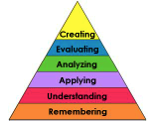Create a Standards-Based Integrated Performance Assessment Unit
Step-by-Step
Step 3: Identify Instructional Goals
After selecting a theme and essential question, the next step is to describe what the learners will know and be able to do as a result of completing the unit of instruction. Think of both the content and linguistic goals for your unit. For example, the teachers for the university-level course in Italian identified the following goals:
Content goals:
- Students will be able to identify the characteristics of Italian comedy.
- Students will be able to describe how Italian comedy has changed over the last fifty years.
- Students will be able to create an original story that reflects the characteristics of Italian comedy.
Linguistic goals:
- Students will be able to read about and discuss the history of Italian comedy.
- Students will be able to participate in a discussion asking and responding to a variety of questions, expressing and supporting personal opinions about various Italian comedies.
- Students will be able to write a script and film an original story that reflects the characteristics of Italian comedy.
- Students will be able to make suggestions and critique the original comedies created by their classmates.
Bloom's Taxonomy is helpful in writing learning goals. The following list suggests action verbs for each level of the taxonomy.
Action Verbs for creating instructional goals
(Bloom's Revised Taxonomy)
Level 1. Remember
Choose
Count
Describe
Define
DrawIdentify
Label
List
Locate
MatchMemorize
Name
Omit
Outline
PointQuote
Read
Recall
Recite
RecognizeRepeat
Reproduce
Select
State
Level 2. Understand
Associate
Classify
Compute
Convert
Defend
DemonstrateDiscuss
Distinguish
Estimate
Explain
Express
ExtendExtrapolate
Generalize
Give Examples
Illustrate
Indicate
InferInterpret
Interrelate
Match
Paraphrase
Predict
RepresentRestate
Rewrite
Show
Summarize
Tell
Translate
Level 3. Apply
Add
Apply
Calculate
Change
Choose
ClassifyComplete
Compute
Discover
Divide
Modify
DramatizeExamine
Explain
Generalize
Produce
Graph
InterpolateManipulate
Operate
Organize
Paint
Prepare
SelectShow
Sketch
Solve
Subtract
Use
Level 4. Analyze
Analyze
Arrange
Breakdown
Categorize
ClassifyCombine
Compare
Design
Detect
Develop
Diagram
Differentiate
Discriminate
Distinguish
IdentifyIllustrate
Infer
Outline
Point out
RelateSelect
Separate
Subdivide
Survey
Utilize
Level 5. Evaluate
Appraise
Assess
Compare
ConcludeContrast
Criticize
Critique
DefendDetermine
Grade
Judge
JustifyMeasure
Rank
RateSupport
Test
Level 6. Create
Choose
Combine
Compile
Compose
Construct
Create
DesignDevelop
Devise
Do
Drive
Explain
Formulate
GenerateGroup
Hypothesize
Integrate
Invent
Make
Organize
OriginatePlan
Prescribe
Produce
Propose
Rearrange
Reconstruct
ReorganizeRevise
Rewrite
Role Play
Tell
Transform
Now think about the unit on the market in the middle school Spanish class (explained in the video in Step 2). In the space provided, write potential content and linguistic goals for this unit.
Content goals:
- Students will be able to convert prices for items from pesos to dollars.
- Students will be able to identify what you can buy at an open air market in Mexico.
- Students will be able to compare shopping in a grocery store to shopping in an open market in Mexico.
Linguistic goals:
- Students will be able to understand the prices for items sold in an open air market in Mexico.
- Students will be able to list items found in an open air market in Mexico.
- Students will be able to bargain with someone in order to complete a purchase in an open air market situation.

